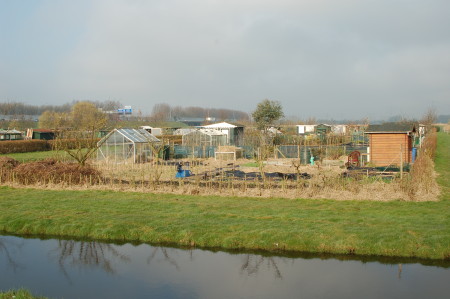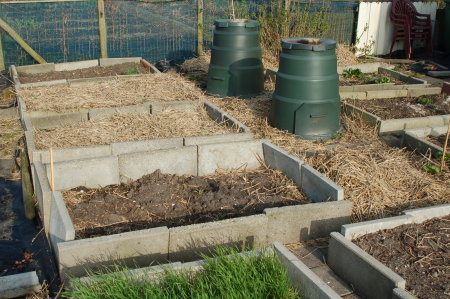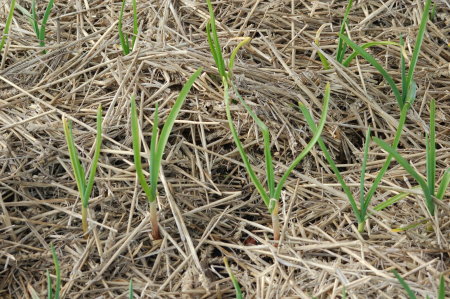
Here’s what the garden looks like. For reference, the tiny patch of green in the middle is the spelt you see in the picture below. You can’t usually see everything so clearly, but nothing has really started to grow and I recently did a very severe cutting back of the hedge, so it’s all a bit more visible.
The blue thing is my upside down wheelbarrow. My garlic is growing on the left side, between the pile of brush left over from cutting the hedge and the greenhouse. The straw is mostly for covering the garlic, but the main cost is having a local farmer make a delivery, getting extra straw is almost free, so I’m using it as a mulch for much of the rest of the garden. I’m also using black landscape fabric in a few places.
You can’t really see, but there’s a line of fruit trees across the front, along the hedge. There are all growing too close to each other, and the ground they are on is very depleted and waterlogged. I trimmed them back pretty severely this year, as well as removing a few to give the others more space. Only one tree gave edible fruit last year, and if the others don’t improve soon I’ll remove them all over the course of the next few years. I’ve also planted some black alder trees next to the fruit trees as well as several other places in the garden, which are nitrogen fixing, in an effort to improve the soil and feed the fruit trees.

The guy who had the garden before me used it more for summer recreation than growing vegetables, and one of the things he did was put down a huge number of paving slabs, about 100 stones in total, taking up around 15% of the space in the garden with firmly established weeds growing aggressively through all the cracks. They were a real maintenance issue, and were taking up too much garden space. These are astonishingly heavy, with one slab being at about my lifting limit. Getting rid of them was really going to be a problem, because it’s a long walk from my garden to the street and I was going to have to carry them one at a time. Most things can be brought to the dump for free disposal, but not paving slabs, so I was going to have to pay to dispose of them.
It was really a lot of work, and took most of last summer, but the solution was to turn them into raised beds, 9 in total with plans for a 10th this year. Not all the stones are straight, and I’ll have to fix this over time, but mostly I’m pretty happy with how it came out.
I made a sketch last year of the garden layout. These raised beds are where the former patio in front of the shed was, as well as where the cold frame used to be. You can see the red current plant in the back corner, but this will likely come out this year to make room for the 10th raised bed.
The green grassy looking stuff at the bottom is spelt I planted last year.

Finally here’s the garlic growing in the straw. I have around 60 varieties growing this year, down from last year’s 100. I’m growing about 1000 bulbs in total on about 45m2. It’s looking good so far.


Hi Patrick, Your allotment is looking so good! That was really a clever solution to turn the heavy pavers into raised beds. That took a lot of chutzpah to load up all those pavers, unload load, and then make a patio! Sheesh! Your garlic looks so good, I know you grow so many colorful varieties. I don’t like the flavor of garlic, but the heirloom varieties are an artists’ dream.
Good show with the slabs! I just love it when problems turn into gifts! How does being so close to the water work for you? Is it potable? Is it necessary to water or irrigate you garden because of the water level? Or does watering become mote?
Patrick,
That is a lot of garlic! So do you eat it or sell it at the market? My Meg’s daughter braids garlic and sells it at the market for her dad.
Lzyjo: It’s funny how one person’s excitement in building a patio turns into another person’s headache. It’s really something for everyone to think about, the legacy you leave for others.
The wonderful thing about gardening is there are so many plants to choose from, if you don’t like garlic, you can always look further to the cabbages or beets. There’s something for everyone. For me it’s always the variety that’s better than any one kind of plant. Thanks for leaving the comment!
Jo: Because I’m in a city (and some houseboats in the area discharge directly into the canals), the water isn’t clean and isn’t good to use in the garden. My garden sits about 3 feet (1 meter) below sea level, but the area is drained with a series of dikes, canals and water pumps.
Because the water is always coming up from the ground and being drawn out, the garden stays clean and the water under the ground is clean. If I wanted I suppose, I could dig a sort of well, but it works better to collect water from the roofs of the greenhouse and shed because there’s a lot of rain here. Otherwise there’s no other source of water in the area, and I did come pretty close to running out last year during a dry spell.
Plants with roots at least a foot deep (30cm) have no problem getting their own water. Since the ground is very sandy, I do sometimes have a hard time getting seeds to germinate or keeping shallow rooted plants alive in dry weather. I rarely need to water my plants.
Randy: I keep meaning to have a go at braiding garlic, but I haven’t gotten around to it yet. My favorite garlics are the hard neck varieties, and you can’t braid these anyway, because they are too stiff.
Mostly I eat it myself, send it to other gardeners to use as planting stock, or give it away to my neighbors and friends. I do end up throwing some away this time of year… Once I figure out the best varieties to grow, and it gets to the point where enough other gardeners in Europe are growing and sharing these varieties, I’ll probably grow less. Right now I’m one of the few sources of non-commercial garlic planting stock in Europe.
Hi Patrick,
Interesting to see your plot again and read about what you are doing. Those concrete slabs would also be good in the greenhouse as a bit of thermal mass.
Hi Kate, good idea about thermal mass. Nice to hear from you.
Does your plot suffer from waterlogging? Mine is also next to a stream, and has always got very wet in winter. It’s been waterlogged at times in summer as well the last couple of years, and plants have really suffered. That may be why some of your asparagus doesn’t come up; mine keeps disappearing.
My plot is on the dry end of the complex, and having canals on three sides really help the water to drain. I have a lot of things in raised beds, including the asparagus, and these always stay dry. I do have a few places that are wetter than others, but nothing serious. A few of the other plots are often flooded.
Once a year we have to dredge the canals, and I am always very aggressive doing this, and I think this helps a lot not just to help the water drain but also to build up the sides of the canals and keep them from washing away.